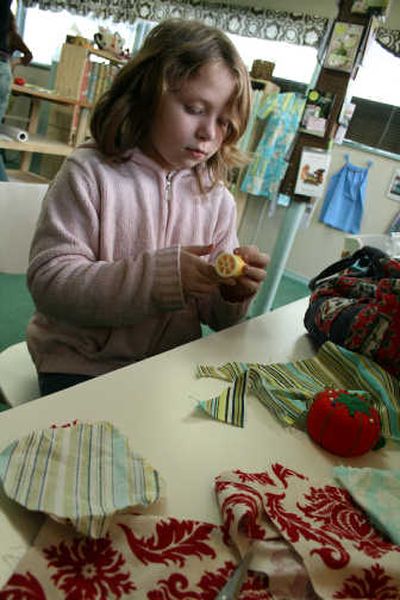Sewing fanatics unite in Stitch Cafe on North Side

Nyla Pipes runs a sewing business out of her home during the week, doing upholstery and making home décor accessories for clients.
But on weekends lately, she’s been sewing at The Top Stitch, a new fabric store on Spokane’s near North Side that allows customers to rent sewing machines, use cutting tables and press seams during its Stitch Cafe hours.
“I sew alone a lot,” Pipes says. “It’s nice to have some company.”
Owner Carrie Jarvis opened The Top Stitch in December, modeling it after similar businesses in Europe and the wildly popular Stitch Lounge in San Francisco. Customers can work independently, come with a group of friends or make new acquaintances as they grapple through projects and patterns side by side. Each four-hour session costs $10, and Jarvis lends her expertise when sewers hit a snag.
The Top Stitch is capitalizing on a national trend: the resurgence of sewing. Some attribute sewing’s rebirth and the celebration of all things handmade to the popularity of the Bravo TV show “Project Runway,” a competition-based reality show that pits fashion designers against one another.
But sewing has always been cool to Jarvis.
She learned the craft at age 9, when a tailor in the Montana town where she grew up took Jarvis under her wing.
“I was infatuated with what she was doing,” Jarvis says.
As a teenager, Jarvis sewed prom dresses, cheerleading outfits and drill team uniforms.
She ran a home-based sewing business for years, but with her son growing older (he’s in middle school) and her husband busy at work (he’s a nurse), she longed to do more.
She started to notice some hip new fabric companies creeping onto the scene. Amy Butler Design, for example, makes vintage-inspired, boldly colored fabrics. Designer Jennifer Paganelli gives florals and other classic patterns a modern twist.
“These were they types of fabrics I grew up with,” Jarvis says. “When I saw these, I thought, ‘Now I’m comfortable again.’ “
Jarvis opened her shop, at 1717 W. Garland Ave., and now carries products from those designers and others. The brightly colored fabric bolts have as much pop as bubble gum, and Jarvis refers to a new collection she has on order as “yummy.”
“Literally,” she says. “It looks like sherbet.”
Also on display are several garments and home décor pieces Jarvis made following patterns by designers like Butler and her contemporaries, which also are sold at The Top Stitch.
What’s missing are the huge catalogs and cabinet drawers full of conventional patterns found at most sewing stores. Jarvis says if you’ve ever tried to follow one of those mass-produced patterns and become confused, you’re not alone. She has found that patterns written by some of the new, smaller-scale companies are easier to follow and produce more modern-looking results.
The Top Stitch’s renters are as young as 8 and as old as almost 80. She says a generation of women who missed out on learning how to make things by hand – often because their mothers were breaking into the working world while they were young – are discovering sewing for the first time.
For those sewers, their children, or anyone with the desire to learn, Jarvis also teaches classes. During those classes and during the Stitch Cafe hours, sewers can use Jarvis’ machines or bring their own.
On a recent Saturday, Nyla Pipes passed on using one of Jarvis’ modern machines in favor of the late-1950s model Singer she uses at home. Pipes bought the old-school Singer at Value Village for $5 and uses it for her clients’ projects.
Her task that Saturday was to create a ring bearer pillow and a garter belt for her sister-in-law’s wedding. Pipes paused occasionally to help 8-year-old Leslee Wilson, who was at the shop with her mom, sew a fabric flower like the one Pipes was wearing on her colorful, handmade apron.
Nearby, customer Megan Hayes meticulously cut fabric to make a handbag for her sister following an Amy Butler pattern. She’d already made one for another sister using some of The Top Stitch’s most vibrant fabric, but this one was for her more conservative sibling so she stuck with a chartreuse polka dot pattern.
The women talked as they worked, with the conversation drifting from raising children to careers to their experience – or lack thereof – as sewers. Besides being a break from her home studio, Pipes says attending the Stitch Cafe sessions offers another perk:
“You learn from each other.”